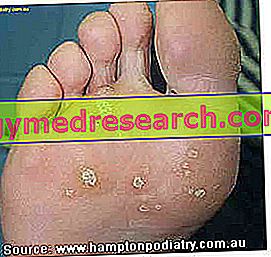What are plantar warts?
Plantar warts are small but very annoying skin growths that originate between the toes or along their plant. Still caused by an infection sustained by the Papilloma virus, plantar warts are fortunately a phenomenon that, however irritating and unpleasant, turns out to be self-limiting and easily treatable.

Incidence
Plantar warts are a widespread phenomenon in industrialized countries: the incidence peak is recorded in children aged between 12 and 16, among the elderly and in people who constantly use public showers or baths.
It is curious to know how plantar warts represent a rather rare event in indigenous populations. In fact, the habit of walking and running without shoes allows these peoples to strengthen and thicken the plantar skin, while keeping the foot dry: in doing so, the foot "protects" itself from infections, keeping the warts away. The friction created by the contact with the ground, in fact, prevents the Papilloma virus from taking root in the skin of the foot, so the risk of plantar warts is almost minimal.
Just to reveal some statistical data, American research has shown that, while 7-10% of the "common" population in the USA is annually affected by plantar warts, only 0.29% of people who do not wear shoes suffer from the same disorder.
Causes and risk factors
CAUSES
Plantar warts are mainly caused by the attack of one of the over seventy papilloma viruses affecting humans ( Human Papilloma Virus or HPV).
In most cases, the infection is contracted by simple direct contact, touching the warts of others or by resting the foot on an infected surface. The papilloma virus, by introducing itself through microabrasions or small cuts, bypasses the defenses of the skin of the feet, laying the foundations for the development of plantar warts.
RISK FACTORS
The main risk factors for transmitting the infection are:
- Use of shared showers and toilets
- Presence of microtrauma on the skin of the foot
- Weakening of the drug-induced immune system (eg long-term treatment with corticosteroids) or diseases (eg AIDS)
Signs and symptoms
Sneaky and unfair, the plantar wart virus - after having intruded into the microtips of the foot - can remain silent for long periods, without showing any symptoms. Despite the incubation period of the virus - time between the moment of infection and the manifestation of symptoms - it is not proved with certainty, it is considered possible that the pathogen may remain silent for many weeks, some months or even years, as long as the optimal conditions do not arise to show all its virulence.
Symptoms begin suddenly with severe pain in the foot, perceived as a callous lesion under the plant or between the toes. Unlike the warts of the hands, those of the feet are more painful because they grow in an area continuously exposed to pressure, rubbing and friction.
At the sight, the plantar warts appear as small punctate skin lesions, generally from the inside darker than the periphery. Their surface is rough, and has a color range ranging from yellow to dark brown. In the most serious cases, the warts can magnify and multiply, to the point of creating massive clusters of warts, such as to make the gait difficult and painful.
Classification
Based on the characteristics of the lesion and their location, the plantar warts are usually classified in three different variants. The distinctive features of the most common forms of warts are summarized in the table.
Type of plantar wart | General characteristics |
Simple plantar wart | The most common variant of all, simple plantar warts are mainly caused by papilloma virus type 1. To the touch, the lesions are rough and irregular; they have a round shape and a color scheme that turns from golden to brownish. Most often, the virus gives rise to a single lesion; often, however, more warts may appear of variable size from 1 to 5 mm. |
Periungual plantar warts  | As the term implies, this type of warts tends to grow along the nail edge (of the toenails); sometimes they can also form under the nail bed. Extremely contagious, periungual warts are usually caused by an infection caused by type 2 papilloma virus. |
Mosaic plantar warts  | A less common variant, so-called mosaic warts are caused by HPV type II. These warts dress in this bizarre name in memory of the particular way in which the characteristic signs manifest themselves: the mosaic warts are characterized by the presence of small crusts, whose arrangement reminds precisely that of a mosaic. Mosaic warts are very contagious and tend to recur quickly even after surgical removal. |
Continue: Plantar Warts: Diagnosis, Prevention, Care »



